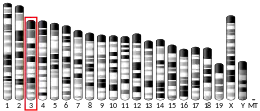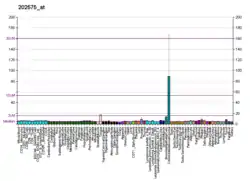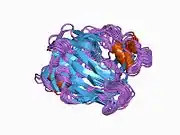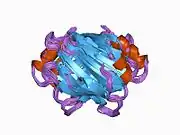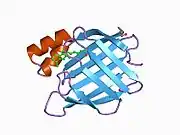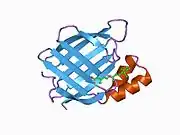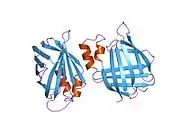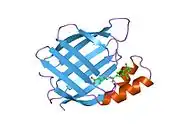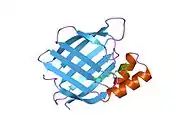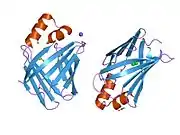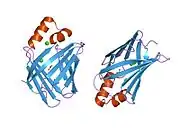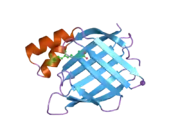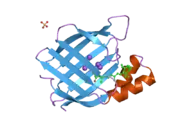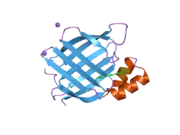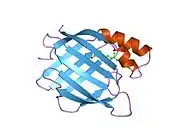| CRABP2 | |||||||||||||||||||||||||||||||||||||||||||||||||||
|---|---|---|---|---|---|---|---|---|---|---|---|---|---|---|---|---|---|---|---|---|---|---|---|---|---|---|---|---|---|---|---|---|---|---|---|---|---|---|---|---|---|---|---|---|---|---|---|---|---|---|---|
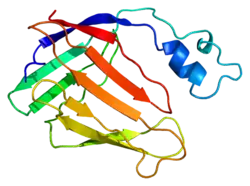 | |||||||||||||||||||||||||||||||||||||||||||||||||||
| |||||||||||||||||||||||||||||||||||||||||||||||||||
| Identifiers | |||||||||||||||||||||||||||||||||||||||||||||||||||
| Aliases | CRABP2, CRABP-II, RBP6, cellular retinoic acid binding protein 2 | ||||||||||||||||||||||||||||||||||||||||||||||||||
| External IDs | OMIM: 180231 MGI: 88491 HomoloGene: 1415 GeneCards: CRABP2 | ||||||||||||||||||||||||||||||||||||||||||||||||||
| |||||||||||||||||||||||||||||||||||||||||||||||||||
| |||||||||||||||||||||||||||||||||||||||||||||||||||
| |||||||||||||||||||||||||||||||||||||||||||||||||||
| |||||||||||||||||||||||||||||||||||||||||||||||||||
| |||||||||||||||||||||||||||||||||||||||||||||||||||
| Wikidata | |||||||||||||||||||||||||||||||||||||||||||||||||||
| |||||||||||||||||||||||||||||||||||||||||||||||||||
Cellular retinoic acid-binding protein 2 is a cytoplasmic binding protein that in humans is encoded by the CRABP2 gene.[5][6][7]
CRABP2 is structurally similar to CRABP1, but CRABP2 has a lower affinity for retinoic acid (RA).[5] CRABP2 is associated with cells that produce large amounts of retinoic acid and may play a role in mediating the effects of retinoic acid in the cell.[5][8]
Function
A number of specific carrier proteins for members of the vitamin A family have been discovered. Retinoic acid is an active metabolite of vitamin A (retinol).[8] Cellular retinoic acid binding proteins (CRABP) are low molecular weight proteins whose precise function remains largely unknown.
The inducibility of the CRABP2 gene suggests that this isoform is important in retinoic acid-mediated regulation of human skin growth, differentiation and development. CRABP2 is involved in the metabolism and transportation of retinoic acid from the cytosol to the RARs (retinoic acid receptors) located in the nucleus.[5][7][8][9] CRABP2 is specifically co-expressed with RAR-β and cellular retinol binding protein 1 genes in certain tissues.[5] It has been postulated that the CRABP2 gene is transcriptionally regulated by a newly synthesized regulatory protein.[7]
Tissue distribution
Tissue distribution of the CRABP2 gene has primarily been studied using mouse models. During embryonic development, CRABP2 is present in tissues throughout the body in a more diffuse pattern than CRABP1.[5] CRABP1 is more isolated to specific regions, though it does appear in higher concentrations.[5] CRABP1 and 2 often overlap in tissues.[5]
CRABP2 gene expression is abundant in the trunk and hindbrain (and to a lesser extent the forebrain), but are present in other areas of the body.[5] Structures such as the limbs, hindbrain and cranial neural crest cells have been shown to be excessively sensitive to high levels of retinoic acid.[5] Rhombomere segmentation in the hindbrain and the development of cranial ganglia V, VII, VIII, IX, and X also appear to be partially dependent on CRABP2 expression.[5] CRABP2 is abundant in the dorsal part of the limb during development.[5]
CRABP2 genes are also expressed in structures that are less sensitive to retinoid levels throughout the body during embryonic development.[5] These structures include the pharyngeal pouches, foregut, midgut, mandibular and frontal mesenchyme, developing muscle, interdigital mesenchyme, the urogenital system, optic vessels, and inner ear sensory epithelium.[5]
Defects
Vitamin A deficiency in mice has been shown to cause problems with spermatogenesis, irregular estrous cycles, changes in the uterine epithelium and reproductive failure ending with fetal death and reabsorption.[8]
Tissues with CRABP2 can be sensitive to high levels of retinoic acid which may cause defects in the development of those tissues.[5]
CRABP2 gene knockout studies should be performed to determine any specific defects caused by loss of this gene.
Interactions
References
- 1 2 3 GRCh38: Ensembl release 89: ENSG00000143320 - Ensembl, May 2017
- 1 2 3 GRCm38: Ensembl release 89: ENSMUSG00000004885 - Ensembl, May 2017
- ↑ "Human PubMed Reference:". National Center for Biotechnology Information, U.S. National Library of Medicine.
- ↑ "Mouse PubMed Reference:". National Center for Biotechnology Information, U.S. National Library of Medicine.
- 1 2 3 4 5 6 7 8 9 10 11 12 13 14 15 Ruberte E, Friederich V, Morriss-Kay G, Chambon P (Aug 1992). "Differential distribution patterns of CRABP I and CRABP II transcripts during mouse embryogenesis". Development. 115 (4): 973–987. doi:10.1242/dev.115.4.973. PMID 1333403. Archived from the original on 2016-03-04. Retrieved 2015-04-15.
- ↑ Aström A, Tavakkol A, Pettersson U, Cromie M, Elder JT, Voorhees JJ (Sep 1991). "Molecular cloning of two human cellular retinoic acid-binding proteins (CRABP). Retinoic acid-induced expression of CRABP-II but not CRABP-I in adult human skin in vivo and in skin fibroblasts in vitro". The Journal of Biological Chemistry. 266 (26): 17662–6. doi:10.1016/S0021-9258(19)47422-X. PMID 1654334.
- 1 2 3 "Entrez Gene: CRABP2 cellular retinoic acid binding protein 2".
- 1 2 3 4 Zheng WL, Ong DE (Apr 1998). "Spatial and temporal patterns of expression of cellular retinol-binding protein and cellular retinoic acid-binding proteins in rat uterus during early pregnancy". Biology of Reproduction. 58 (4): 963–970. doi:10.1095/biolreprod58.4.963. PMID 9546726.
- ↑ Maden M, Ong DE, Summerbell D, Chytil F (April 1989). "The role of retinoid-binding proteins in the generation of pattern in the developing limb, the regenerating limb and the nervous system". Development. 107 Suppl: 109–119. doi:10.1242/dev.107.Supplement.109. PMID 2561479. Archived from the original on 2016-03-04. Retrieved 2015-04-15.
- ↑ Despouy G, Bastie JN, Deshaies S, Balitrand N, Mazharian A, Rochette-Egly C, Chomienne C, Delva L (Feb 2003). "Cyclin D3 is a cofactor of retinoic acid receptors, modulating their activity in the presence of cellular retinoic acid-binding protein II". The Journal of Biological Chemistry. 278 (8): 6355–62. doi:10.1074/jbc.M210697200. PMID 12482873.
External links
- Human CRABP2 genome location and CRABP2 gene details page in the UCSC Genome Browser.
Further reading
- Eller MS, Oleksiak MF, McQuaid TJ, McAfee SG, Gilchrest BA (Feb 1992). "The molecular cloning and expression of two CRABP cDNAs from human skin". Experimental Cell Research. 198 (2): 328–36. doi:10.1016/0014-4827(92)90387-N. PMID 1309505.
- Elder JT, Aström A, Pettersson U, Voorhees JJ, Trent JM (Jul 1992). "Assignment of the human CRABP-II gene to chromosome 1q21 by nonisotopic in situ hybridization" (PDF). Human Genetics. 89 (5): 487–90. doi:10.1007/BF00219171. hdl:2027.42/47631. PMID 1321791. S2CID 24955299.
- Aström A, Pettersson U, Voorhees JJ (Dec 1992). "Structure of the human cellular retinoic acid-binding protein II gene. Early transcriptional regulation by retinoic acid". The Journal of Biological Chemistry. 267 (35): 25251–5. doi:10.1016/S0021-9258(19)74033-2. PMID 1334086.
- Thompson JR, Bratt JM, Banaszak LJ (Sep 1995). "Crystal structure of cellular retinoic acid binding protein I shows increased access to the binding cavity due to formation of an intermolecular beta-sheet". Journal of Molecular Biology. 252 (4): 433–46. doi:10.1006/jmbi.1995.0509. PMID 7563063.
- Kleywegt GJ, Bergfors T, Senn H, Le Motte P, Gsell B, Shudo K, Jones TA (Dec 1994). "Crystal structures of cellular retinoic acid binding proteins I and II in complex with all-trans-retinoic acid and a synthetic retinoid". Structure. 2 (12): 1241–58. doi:10.1016/S0969-2126(94)00125-1. PMID 7704533.
- Stephanou A, Sarlis NJ, Richards R, Handwerger S (Jul 1994). "Expression of retinoic acid receptor subtypes and cellular retinoic acid binding protein-II mRNAs during differentiation of human trophoblast cells". Biochemical and Biophysical Research Communications. 202 (2): 772–80. doi:10.1006/bbrc.1994.1997. PMID 8048948.
- Sanquer S, Eller MS, Gilchrest BA (Feb 1993). "Retinoids and state of differentiation modulate CRABP II gene expression in a skin equivalent". The Journal of Investigative Dermatology. 100 (2): 148–53. doi:10.1111/1523-1747.ep12462785. PMID 8381448.
- Wang L, Li Y, Yan H (Jan 1997). "Structure-function relationships of cellular retinoic acid-binding proteins. Quantitative analysis of the ligand binding properties of the wild-type proteins and site-directed mutants". The Journal of Biological Chemistry. 272 (3): 1541–7. doi:10.1074/jbc.272.3.1541. PMID 8999826.
- Flagiello D, Apiou F, Gibaud A, Poupon MF, Dutrillaux B, Malfoy B (1997). "Assignment of the genes for cellular retinoic acid binding protein 1 (CRABP1) and 2 (CRABP2) to human chromosome band 15q24 and 1q21.3, respectively, by in situ hybridization". Cytogenetics and Cell Genetics. 76 (1–2): 17–8. doi:10.1159/000134502. PMID 9154115.
- Brar AK, Kessler CA, Meyer AJ, Cedars MI, Jikihara H (Mar 1996). "Retinoic acid suppresses in-vitro decidualization of human endometrial stromal cells". Molecular Human Reproduction. 2 (3): 185–93. doi:10.1093/molehr/2.3.185. PMID 9238678.
- Chen X, Tordova M, Gilliland GL, Wang L, Li Y, Yan H, Ji X (May 1998). "Crystal structure of apo-cellular retinoic acid-binding protein type II (R111M) suggests a mechanism of ligand entry". Journal of Molecular Biology. 278 (3): 641–53. doi:10.1006/jmbi.1998.1734. PMID 9600845.
- Wang L, Li Y, Abildgaard F, Markley JL, Yan H (Sep 1998). "NMR solution structure of type II human cellular retinoic acid binding protein: implications for ligand binding". Biochemistry. 37 (37): 12727–36. doi:10.1021/bi9808924. PMID 9737849.
- Wang L, Yan H (Sep 1998). "NMR study suggests a major role for Arg111 in maintaining the structure and dynamical properties of type II human cellular retinoic acid binding protein". Biochemistry. 37 (37): 13021–32. doi:10.1021/bi981021x. PMID 9737883.
- Chaudhuri BN, Kleywegt GJ, Broutin-L'Hermite I, Bergfors T, Senn H, Le Motte P, Partouche O, Jones TA (Nov 1999). "Structures of cellular retinoic acid binding proteins I and II in complex with synthetic retinoids". Acta Crystallographica Section D. 55 (Pt 11): 1850–7. doi:10.1107/S0907444999011026. PMID 10531482.
- Budhu AS, Noy N (Apr 2002). "Direct channeling of retinoic acid between cellular retinoic acid-binding protein II and retinoic acid receptor sensitizes mammary carcinoma cells to retinoic acid-induced growth arrest". Molecular and Cellular Biology. 22 (8): 2632–41. doi:10.1128/MCB.22.8.2632-2641.2002. PMC 133717. PMID 11909957.
- Despouy G, Bastie JN, Deshaies S, Balitrand N, Mazharian A, Rochette-Egly C, Chomienne C, Delva L (Feb 2003). "Cyclin D3 is a cofactor of retinoic acid receptors, modulating their activity in the presence of cellular retinoic acid-binding protein II". The Journal of Biological Chemistry. 278 (8): 6355–62. doi:10.1074/jbc.M210697200. PMID 12482873.
- Behrens GM, Genschel J, Schmidt RE, Schmidt HH (May 2003). "Lack of mutations in LMNA, its promoter region, and the cellular retinoic acid binding protein II (CRABP II) in HIV associated lipodystrophy". European Journal of Medical Research. 8 (5): 221–5. PMID 12844477.
- Van den Bogaerdt AJ, El Ghalbzouri A, Hensbergen PJ, Reijnen L, Verkerk M, Kroon-Smits M, Middelkoop E, Ulrich MM (Mar 2004). "Differential expression of CRABP-II in fibroblasts derived from dermis and subcutaneous fat". Biochemical and Biophysical Research Communications. 315 (2): 428–33. doi:10.1016/j.bbrc.2004.01.069. PMID 14766225.


